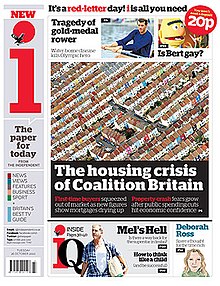Since I am producing a local newspaper I decided to conduct some research into how well they are doing now and what sort of future regional newspapers have. Then I can understand better how to move local newspapers forward and discover how to attract new audiences.
Below is a news article on the BBC News website. Although my main task is creating a paper version of a local newspaper I am also designing an online production and therefore researching into news stories online benefits both products. On one hand I can analyse the language used, and since it is published on the internet I can hypothesise that the lexical choices will be more informal than a paper version, and therefore aid me in my attempt at targeting my product at a younger audience, and on the other I can analyse the graphology and discourse structure of the website, already gaining ideas about my own product.
The main graphological feature is the top image, which is smaller than I anticipated for a main image. The camera focuses of the newspapers which are situated in the right of the picture. This makes it interesting for the viewer because the picture sticks to the rule of thirds, and the focus is not in the centre. Not counting the image of the journalist at the bottom this is the only image on the page which makes it very bland and boring. The headline isn't as bold as I thought which is something I will adjust in my own product. Under the headline I like how there is a sentence summary of the whole news article, which is something that I will keep in mind. The language used throughout the whole article is unbiased and general, which is something the BBC recognised for. The bottom of the article shows the journalist who wrote it, along with links to follow him on Twitter, a social networking site, and a few snippets of his recent Tweets. This, I am assuming, is the BBC trying to keep up to date with new technologies, and by doing this trying to attract a younger audience.
Overall this newspaper article discusses the decline of regional newspapers using a range of features that I will also hope to use when creating my own products.
To round up my own ideas for creating a web page I will be using some conventions from this product, such as summing up the whole news story in one sentence to draw the reader in by using emotive language. I will also place an image of the journalist somewhere in the article which would give, if this were a real, the writer a sense of pride in their work and feel more involved in the paper. By linking in Twitter and other social networking sites it anchors the products audience, being teenagers/young people. The graphology, bar what I have previously mentioned, will be different in my own work. The typography will be less formal, though still keeping in with the conventions of other existing products. There will be more than one image placed around the article, to keep the readers attention and also making the text visually attractive. I will be placing hyperlinks throughout the text, like the above work. The headline here, I feel, is a let down. My own headline on the website will be bolder, darker, and will stand out from the page. A feature that is not a convention here but hopefully will be on my own product is linking the reader to other related articles. This keeps the reader on the website by sparking their interest.
My own newspaper website will contain articles that will look visually similar to this, but have certain features to make my own product better suited to young people.
In terms of analysing the text of this article it is noted that statistics are used in the first paragraph, which allows the journalist to gain the readers trust by backing up his point with facts. It also includes hyperlinks to other websites where readers can view research sources. Obviously, this being posted on a website, hyperlinks can be included whereas a printed version could not include links to other websites. The tone of the text is more informal than a newspaper, because websites that display news are designed for people who want to catch up with the world on their lunch break. However, my own tone for both my newspaper and my website will be the same because I want to attract a younger audience; one who reads their news online because of the informal register.
The journalist reporting for the BBC quotes another newspaper, 'The Guardian' which is highly unusual and even links the viewer to their website. Once should be more than enough but 'Torin' the journalist again comments on what 'The Guardian' has reported in the final paragraph. I personally do not think this is a good idea because I want as many readers to stay with my own product, rather than advertise another newspaper. It also means that the reader loses the firm anchorage that was set by logging onto the BBC.
Overall the articles lexis used is what one would expect from a BBC journalist, and something I want to keep in mind when producing my own work.











